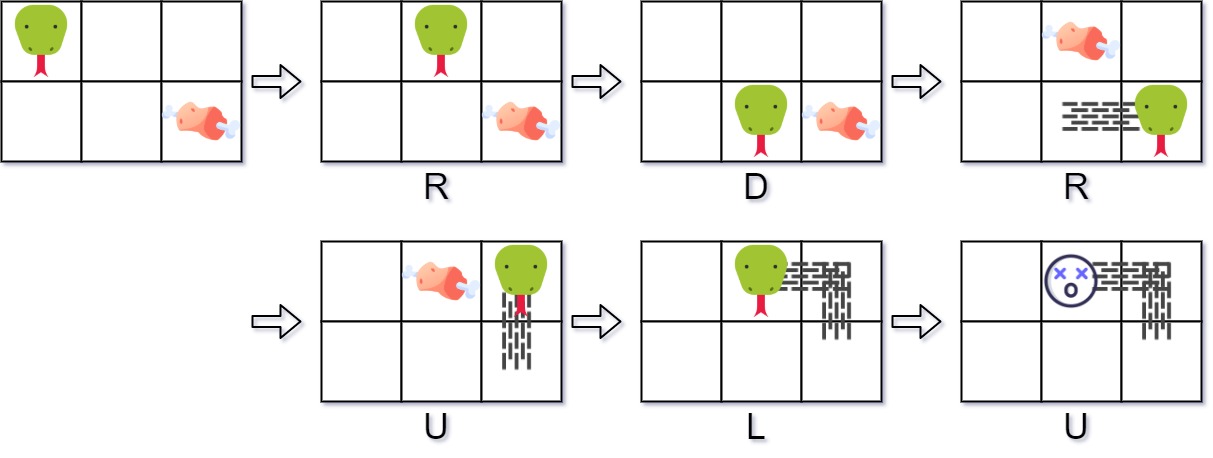0353. 贪吃蛇
大约 4 分钟
--- 
0353. 贪吃蛇
- 标签:设计、队列、数组、哈希表、模拟
- 难度:中等
题目链接
题目大意
要求:
设计一个「贪吃蛇游戏」,该游戏将会在一个「屏幕尺寸 = 宽度 x 高度」的屏幕上运行。如果你不熟悉这个游戏,可以 点击这里 在线试玩。
起初时,蛇在左上角的 位置,身体长度为 个单位。
你将会被给出一个数组形式的食物位置序列 ,其中 。当蛇吃到食物时,身子的长度会增加 个单位,得分也会 。
食物不会同时出现,会按列表的顺序逐一显示在屏幕上。比方讲,第一个食物被蛇吃掉后,第二个食物才会出现。
当一个食物在屏幕上出现时,保证不会出现在被蛇身体占据的格子里。
如果蛇越界(与边界相撞)或者头与「移动后」的身体相撞(即,身长为 的蛇无法与自己相撞),游戏结束。
实现 SnakeGame 类:
SnakeGame(int width, int height, int[][] food)初始化对象,屏幕大小为 ,食物位置序列为 。int move(String direction)返回蛇在方向 上移动后的得分。如果游戏结束,返回 。
说明:
- 。
- 。
- 。
- 。
- 。
- 。
- 为
'U','D','L', or'R'。 - 最多调用 次
move方法。
示例:
- 示例 1:

输入:
["SnakeGame", "move", "move", "move", "move", "move", "move"]
[[3, 2, [[1, 2], [0, 1]]], ["R"], ["D"], ["R"], ["U"], ["L"], ["U"]]
输出:
[null, 0, 0, 1, 1, 2, -1]
解释:
SnakeGame snakeGame = new SnakeGame(3, 2, [[1, 2], [0, 1]]);
snakeGame.move("R"); // 返回 0
snakeGame.move("D"); // 返回 0
snakeGame.move("R"); // 返回 1 ,蛇吃掉了第一个食物,同时第二个食物出现在 (0, 1)
snakeGame.move("U"); // 返回 1
snakeGame.move("L"); // 返回 2 ,蛇吃掉了第二个食物,没有出现更多食物
snakeGame.move("U"); // 返回 -1 ,蛇与边界相撞,游戏结束解题思路
思路 1:队列 + 哈希表
使用双端队列 deque 来存储蛇的身体位置,使用集合 set 来快速检查碰撞。蛇的头部在队列的末尾,尾部在队列的开头。
具体步骤:
初始化:
- 使用双端队列 存储蛇的身体位置,初始位置为 。
- 使用集合 存储蛇身体占据的位置,用于快速碰撞检测。
- 记录屏幕尺寸 和 。
- 记录食物列表 和当前食物索引 。
- 记录当前得分 。
move 操作:
- 根据方向 计算新的头部位置 。
- 检查新位置是否越界: 或 或 或 。
- 检查新位置是否与蛇身碰撞: 在 集合中。
- 如果碰撞,返回 。
- 将新头部加入队列和集合。
- 检查是否吃到食物: 等于当前食物位置。
- 如果吃到食物,得分 ,食物索引 。
- 如果没吃到食物,移除尾部位置。
- 返回当前得分。
思路 1:代码
class SnakeGame:
def __init__(self, width: int, height: int, food: List[List[int]]):
# 初始化屏幕尺寸
self.width = width
self.height = height
# 初始化食物列表和索引
self.food = food
self.food_index = 0
# 初始化蛇的身体(使用双端队列,头部在末尾)
self.snake = deque([(0, 0)])
# 使用集合存储蛇身体占据的位置,用于快速碰撞检测
self.occupied = {(0, 0)}
# 初始化得分
self.score = 0
def move(self, direction: str) -> int:
# 获取当前头部位置
head_row, head_col = self.snake[-1]
# 根据方向计算新的头部位置
if direction == 'U':
new_head = (head_row - 1, head_col)
elif direction == 'D':
new_head = (head_row + 1, head_col)
elif direction == 'L':
new_head = (head_row, head_col - 1)
else: # direction == 'R'
new_head = (head_row, head_col + 1)
# 检查是否越界
if (new_head[0] < 0 or new_head[0] >= self.height or
new_head[1] < 0 or new_head[1] >= self.width):
return -1
# 检查是否吃到食物
eating_food = (self.food_index < len(self.food) and
new_head == tuple(self.food[self.food_index]))
if not eating_food:
# 没吃到食物,先移除尾部
tail = self.snake.popleft()
self.occupied.remove(tail)
# 检查是否与蛇身碰撞(在移除尾部后检查)
if new_head in self.occupied:
return -1
# 将新头部加入蛇身
self.snake.append(new_head)
self.occupied.add(new_head)
if eating_food:
# 吃到食物,得分 +1,食物索引 +1
self.score += 1
self.food_index += 1
return self.score
# Your SnakeGame object will be instantiated and called as such:
# obj = SnakeGame(width, height, food)
# param_1 = obj.move(direction)思路 1:复杂度分析
- 时间复杂度:
move操作:,所有操作都是常数时间。
- 空间复杂度:,其中 是蛇的最大长度。